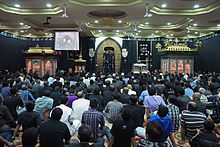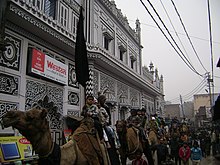Muharram
| Islamic calendar |
|---|
| Months |

Muḥarram (Template:Lang-ar muḥarram) is the first month of the Islamic calendar. It is one of the four sacred months of the year.[1] Since the Islamic calendar is a lunar calendar, Muharram moves from year to year when compared with the Gregorian calendar.
The word "Muharram" means "forbidden". It is held to be the second holiest month, following Ramadan. Some Muslims fast during these days. The tenth day of Muharram is the Day of Ashura, which to Shia Muslims is part of the Mourning of Muharram.
Sunni Muslims fast during this day, because it is recorded in the hadith[2] that Musa (Moses) and his people obtained a victory over the Egyptian Pharaoh on the 10th day of Muharram; accordingly Muhammad asked Muslims to fast on this day that is Ashura and on a day before that is 9th (called Tasu'a).
Shia Muslims during Muharram do different things and with different intentions. Not only Shia people, Sunni sect of Muslim especially the lover of Ahl al-Bayt and Sufi people do the mourning on Imam Hussein. They observe and respect Muharram as the month that martyred Hussein ibn Ali, the grandson of Muhammad and son of Ali, in the Battle of Karbala. They mourn for Hussein ibn Ali and refrain from all joyous events. Unlike Sunni Muslims, Shias do not fast on the 10th day of Muharram.[3] In addition there is an important Ziyarat book, the Ziyarat Ashura about Hussein ibn Ali. In the Shia sect it is popular to read this ziyarat on the "Day of Ashura", although most of the Shias try to read Ziyarat Ashura every day and they send salutations to Hussein ibn Ali.[4] The Sufi sect and followers of Ahl al-Bayt of Sunni Muslim from India, Bangladesh and from various parts of the world reads the Noha, Marsiya and deliver lecture on Imam Hussein's life and his scarification for Islam. Muharram of Sunni peoples of Bengal-especially the Sufi and Ahl al-Bayt lovers are very well known. These Sunni sects do the mourning of Imam Hussain and his Ahl al-Bayt from the first day of Muharram till the forty days after Ashura.
Muharram and Ashura
With the sighting of the new moon the Islamic New Year is ushered in. The first month, Muharram, is one of the four sacred months that Allah has mentioned in the Quran: Muharram, Rajab, Dhu al-Qi'dah, and Dhu al-Hijjah. Even before Islam came, Quraish and Arabs as a whole knew the sanctity of the months and were forbidden to wage wars on those months.
Muharram and Ashura to the Sunnis
Without any relation whatsoever to the event of Battle of Karbala, Muslims are encouraged to observe fasting on the tenth day (Ashura). The ninth day (Tasu'a) is also advised.
Muharram and Ashura to the Shia


Muharram is a month of remembrance and modern Shia meditation that is often considered synonymous with Ashura. Ashura, which literally means the "Tenth" in Arabic, refers to the tenth day of Muharram. It is well-known because of historical significance and mourning for the murder of Hussein ibn Ali, the grandson of Muhammad.[3]
Shiite begin mourning from the first night of Muharram and continue for ten nights, climaxing on the 10th of Muharram, known as the Day of Ashura. The last few days up until and including the Day of Ashura are the most important because these were the days in which Imam Hussein and his family and followers (including women, children and elderly people) were deprived of water from the 7th onward and on the 10th, Imam Hussain and 72 of his followers were killed by the army of Yazid I at the Battle of Karbala on Yazid's orders. The surviving members of Imam Hussein's family and those of his followers were taken captive, marched to Damascus, and imprisoned there.
Timing
The Islamic calendar is a lunar calendar, and months begin when the first crescent of a new moon is sighted. Since the Islamic lunar calendar year is 11 to 12 days shorter than the solar year, Muharram migrates throughout the solar years. The estimated start and end dates for Muharram are as follows (based on the Umm al-Qura calendar of Saudi Arabia:[4])
| AH | First day (CE / AD) | Last day (CE / AD) |
|---|---|---|
| 1431 | 18 December 2009 | 15 January 2010 |
| 1432 | 7 December 2010 | 4 January 2011 |
| 1433 | 26 November 2011 | 25 December 2011 |
| 1434 | 15 November 2012 | 13 December 2012 |
| 1435 | 4 November 2013 | 3 December 2013 |
| 1436 | 25 October 2014 | 22 November 2014 |
| 1437 | 14 October 2015 | 12 November 2015 |
| Muharram dates between 2009 and 2015 | ||
The approximate dates for the next Muharram is from 2 October 2016 to 31 October 2016.[5][6]
Incidents occurred during this month

- 01 Muharram: anniversary of the death of Hazrat Ammasaheb Bibi Habiba Qadri in India; Birth of the Báb (forerunner of the Bahá'í Faith) in 1235 AH.
- 02 Muharram: Hussein ibn Ali enters Karbala and establishes camp. Yazid's forces are present. Birth of Bahá'u'lláh (founder of the Bahá'í Faith) in 1233 AH.
- 07 Muharram: Access to water was banned to Husayn ibn Ali by Yazid's orders.
- 10 Muharram: Referred to as the Day of Ashurah (lit. "the tenth") was the day on which Hussein ibn Ali was martyred in the Battle of Karbala. Shia Muslims spend the day in mourning, whilst the Sunni Muslims fast on this day commemorating the rescue of the people of Israel by Musa (Moses) from Pharaoh[7]
Many Sufi Muslims fast for the same reason as the Sunnis mentioned above, but also for the martyred people in Karbala, they pray for them and send upon them peace and blessings.
- 15 Muharram: Birth of Muhammad Sirajuddin Naqshbandi in 1297 AH (1879-1880 AD)
- 25 Muharram: Zayn al-‘Ābidīn, fourth Shia Imam was martyred by Marvanian in 95 AH (714 AD).[8]
- 27 Muharram, Maytham al-Tammar was martyred.
- 28 Muharram: Death anniversary Urs of Ashraf Jahangir Semnani in 808 AH (1405 AD) a great Sufi saint in India.
- Death anniversary Urs of Baba Farid, a great Sufi saint in Pakistan for six days in Muharram.
See also
References
- ^ The others are Dhu al-Qi'dah, Dhu al-Hijjah and Rajab, The Islamic Calendar
- ^ Volume 3, Book 31, Number 223: Narrated Abu Musa: The day of 'Ashura' was considered as 'Id day by the Jews. So the Prophet ordered, "I recommend you (Muslims) to fast on this day." [1]
- ^ "Muharram". 2010-12-08. Retrieved 2010-12-08.
- ^ Umm al-Qura calendar of Saudi Arabia
- ^ Gent, R.H. van. "The Umm al-Qura Calendar of Saudi Arabia".
- ^ http://www.ummulqura.org.sa/Index.aspx
- ^ Sahih Bukhari 003.031.222-225 Archived 2009-11-26 at the Wayback Machine
- ^ Allama Majlisi. Bihar al-Anwar. Vol. 46. pp. 152–154.
- ^ Ashwani, Shrotriya. "Why Mourning of Muharram, What Happened In The Battle of Karbala", 12 October 2016.
Further reading
- Chelkowski, Peter J. ed. 1979. Ta’ziyeh: Ritual and Drama in Iran. New York: New York University Press.
- Cole, Juan. 1988. Roots of North Indian Shiism in Iran and Iraq: Religion and State in Avadh, 1722-1859. Berkeley, CA: University of California Press.
- Kartomi, Margaret. 1986. ‘Tabut - a Shia Ritual Transplanted from India to Sumatra’, in Nineteenth and Twentieth Century Indonesia: Essays in Honour of Professor J.D. Legge, edited by David P. Chandler and M.C. Ricklefs, Australia: Monash University, Centre for Southeast Asian Studies, 141-162.
- Mason, P.H. (2016) Fight-dancing and the Festival: Tabuik in Pariaman, Indonesia, and Iemanjá in Salvador da Bahia, Brazil. Martial Arts Studies Journal, 2, 71-90. DOI: 10.18573/j.2016.10065
- Pinault, David. 1992. The Shiites: Ritual and Popular Piety in a Muslim Community. London: I.B. Tauris.
